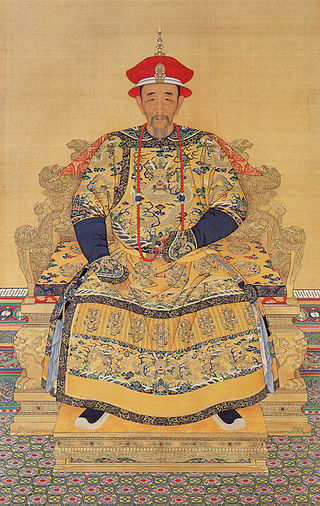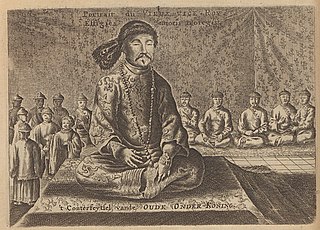| |||||
| Decades: | |||||
|---|---|---|---|---|---|
| See also: | Other events of 1687 History of China • Timeline • Years | ||||
Events from the year 1687 in China .
| |||||
| Decades: | |||||
|---|---|---|---|---|---|
| See also: | Other events of 1687 History of China • Timeline • Years | ||||
Events from the year 1687 in China .


The Qing dynasty, officially the Great Qing, was a Manchu-led imperial dynasty of China and the last imperial dynasty in Chinese history. It emerged from the Later Jin dynasty founded by a Tungusic-speaking ethnic group who became known as the Manchus. The dynasty was officially proclaimed in 1636 in Mukden, and following the Battle of Shanhai Pass it seized control of Beijing in 1644, which is often considered the start of the dynasty's rule in China. Within decades the Qing had consolidated its control over the whole of China proper and Taiwan, and by the mid-18th century it had expanded its rule into Inner Asia. The dynasty lasted until 1912 when it was overthrown in the Xinhai Revolution. In Chinese historiography, the Qing dynasty was preceded by the Ming dynasty and succeeded by the Republic of China. The multiethnic Qing dynasty assembled the territorial base for modern China. It was the largest imperial dynasty in the history of China and in 1790 the fourth-largest empire in world history in terms of territorial size. With 419,264,000 citizens in 1907, it was the most populous country in the world at the time.

The Kangxi Emperor, also known by his temple name Emperor Shengzu of Qing, personal name Xuanye, was the third emperor of the Qing dynasty, and the second Qing emperor to rule over China proper, reigning from 1661 to 1722.

The Shunzhi Emperor was the second emperor of the Qing dynasty of China, and the first Qing emperor to rule over China proper, reigning from 1644 to 1661. A committee of Manchu princes chose him to succeed his father, Hong Taiji (1592–1643), in September 1643, when he was five years old. The princes also appointed two co-regents: Dorgon (1612–1650), the 14th son of the Qing dynasty's founder Nurhaci (1559–1626), and Jirgalang (1599–1655), one of Nurhaci's nephews, both of whom were members of the Qing imperial clan.

Wu Sangui, courtesy name Changbai (長白) or Changbo (長伯), was a notorious Ming dynasty military officer who played a key role in the fall of the Ming dynasty and the founding of the Qing dynasty in China. In Chinese folklore, Wu Sangui is regarded as a disreputable Han Chinese traitor who played a pivotal role in several historical events, including the Battle of Shanhai Pass, Qing conquest of Ming China, the suppression of Southern Ming resistances and the execution of the Yongli Emperor, and eventually double-crossed both of his masters, the Ming and the Qing dynasties.
Suksaha was a Manchu official of the early Qing dynasty from the Nara clan. A military officer who participated in the Manchu conquest of China, Suksaha became one of the Four Regents during the early reign of the Kangxi Emperor in the Qing dynasty (1644–1912). He eventually fell out with another regent, Oboi, and was sentenced to death.

The Revolt of the Three Feudatories, also known as the Rebellion of Wu Sangui, was a rebellion in China lasting from 1673 to 1681, during the early reign of the Kangxi Emperor of the Qing dynasty (1644–1912). The revolt was led by the three lords of the fiefdoms in Yunnan, Guangdong and Fujian provinces against the Qing central government. These hereditary titles had been given to prominent Han Chinese defectors who had helped the Manchu conquer China during the transition from Ming to Qing. The feudatories were supported by Zheng Jing's Kingdom of Tungning in Taiwan, which sent forces to invade Mainland China. Additionally, minor Han military figures, such as Wang Fuchen and the Chahar Mongols, also revolted against Qing rule. After the last remaining Han resistance had been put down, the former princely titles were abolished.

Geng Jingzhong was a powerful military commander of the early Qing dynasty. He inherited the title of "King/Prince of Jingnan" (靖南王) from his father Geng Jimao, who had inherited it from Jingzhong's grandfather Geng Zhongming.

Shang Kexi was a Chinese general of the Ming and Qing dynasties. In 1576, his family migrated to Liaodong, and his father, Shang Xueli, served in the army guarding the northeast frontier. As his father did, Shang Kexi joined the army and guarded the frontier against the attack of the Jurchens. Shang was described to be a brave and resourceful man who was skilful at mounted archery and capable in military matters.
The history of the Qing dynasty began in 1636, when Manchu chieftain Hong Taiji officially proclaimed the Qing dynasty, although the year 1644 is often considered the start of the dynasty's rule in China. The dynasty lasted until 1912, when Puyi abdicated the throne in response to the Xinhai Revolution in 1911. The final imperial dynasty of China, the Qing dynasty reached heights of power unlike any of the Chinese dynasties which preceded it, engaging in large-scale territorial expansion which ended with embarrassing defeat and humiliation to the foreign powers whom they believe to be inferior to them. The Qing dynasty's inability to successfully counter Western and Japanese imperialism ultimately led to its downfall, and the instability which emerged in China during the final years of the dynasty ultimately paved the way for the Warlord Era.

The transition from Ming to Qing or the Manchu conquest of China from 1618 to 1683 saw the transition between two major dynasties in Chinese history. It was a decades-long conflict between the emerging Qing dynasty, the incumbent Ming dynasty, and several smaller factions. It ended with the consolidation of Qing rule, and the fall of the Ming and several other factions.

Geng is the Mandarin pinyin romanization of the Chinese surname written 耿 in Chinese character. It is romanized as Keng in Wade–Giles. Geng is listed 350th in the Song dynasty classic text Hundred Family Surnames. As of 2008, it is the 139th most common surname in China, shared by 990,000 people.
Geng Juzhong was the third son of Geng Jimao and brother of Geng Jingzhong and court member of the Qing dynasty. He was a Third Class Viscount (三等子).
Events from the year 1663 in China. Also known as 壬寅 4359 or 4299 to 卯年 4360 or 4300 in the Earthly Branches calendar.
Events from the year 1667 in China.
Events from the year 1668 in China.
Events from the year 1671 in China.
Events from the year 1674 in China.
Events from the year 1676 in China.
Events from the year 1688 in China.